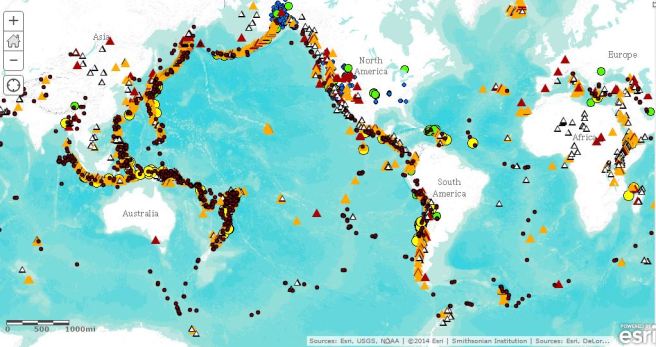Yesterday (10/15/2015), was the day for Great ShakeOut Earthquake Drills. At 10:15 a.m., I was lecturing about volcanoes, when my slides were replaced with an earthquake drill announcement. I told my students that if an actual earthquake were to happen, they should duck under their desks and stay there until the shaking stopped. Then we went back to volcanoes.
While I was talking about what to do in the event of an earthquake, my children practiced ducking under their desks. Worldwide, more than 22 million people participated in yesterday’s earthquake drills. They learned to drop, cover and hold on. But, they didn’t learn what to do once the shaking stops.
Perhaps one of the most helpful things to do after an earthquake is to tweet about it. USGS seismologist Paul Earle teamed up with USGS computer scientist Michelle Guy to develop a method to use tweets to track and detect earthquakes.
Earle and Guy were able to create a time series algorithm that determined when an earthquake occurred by detecting posts that mentioned earthquakes. This was helpful, but after looking at posts in more detail they noticed two things:
- People who were affected by earthquakes kept their initial posts very short.
- People who experienced the quake first hand were less likely to share links or discuss the magnitude of the earthquake.
So, the USGS team decided to filter out tweets with more than seven words, tweets with links, and tweets with numbers. They created filters in many languages.
The USGS has about 2,000 earthquake sensors – most are in the United States. The sensors will detect earthquakes, but it can take several minutes or longer for the seismic waves generated by an earthquake to travel through the Earth and reach a sensor. Scientists need several sensor measurements to triangulate an earthquakes epicenter.
Twitter has more than 300 million users per month. Within 30 seconds, tweets about an earthquake can spread around the world. There is little cost for this information as it uses Twitters Public API and open-source software.
While tweets won’t replace sensors and seismometers, they do provide additional information that can be used for emergency response and damage assessment – especially in areas that don’t have a lot of seismometer coverage.
For more information, click here.
To learn about how social media helped provide information after the Nepal earthquake, click here.
Here are several earthquakes that occurred in Chile on September 25, 2015.
Here are the Twitter statistics. Source: https://blog.twitter.com/2015/usgs-twitter-data-earthquake-detection
Seismogram image of vertical displacement at Las Campanas Astronomical Observatory, 8.3 magnitude earthquake, 9-16-2015. Source IRIS











